Nine spotted lady beetle Stock Photos and Images
 Nine-spotted lady beetle (Coccinella novemnotata) visits an unknown plant. Stock Photohttps://www.alamy.com/image-license-details/?v=1https://www.alamy.com/nine-spotted-lady-beetle-coccinella-novemnotata-visits-an-unknown-plant-image621212510.html
Nine-spotted lady beetle (Coccinella novemnotata) visits an unknown plant. Stock Photohttps://www.alamy.com/image-license-details/?v=1https://www.alamy.com/nine-spotted-lady-beetle-coccinella-novemnotata-visits-an-unknown-plant-image621212510.htmlRM2Y2JJW2–Nine-spotted lady beetle (Coccinella novemnotata) visits an unknown plant.
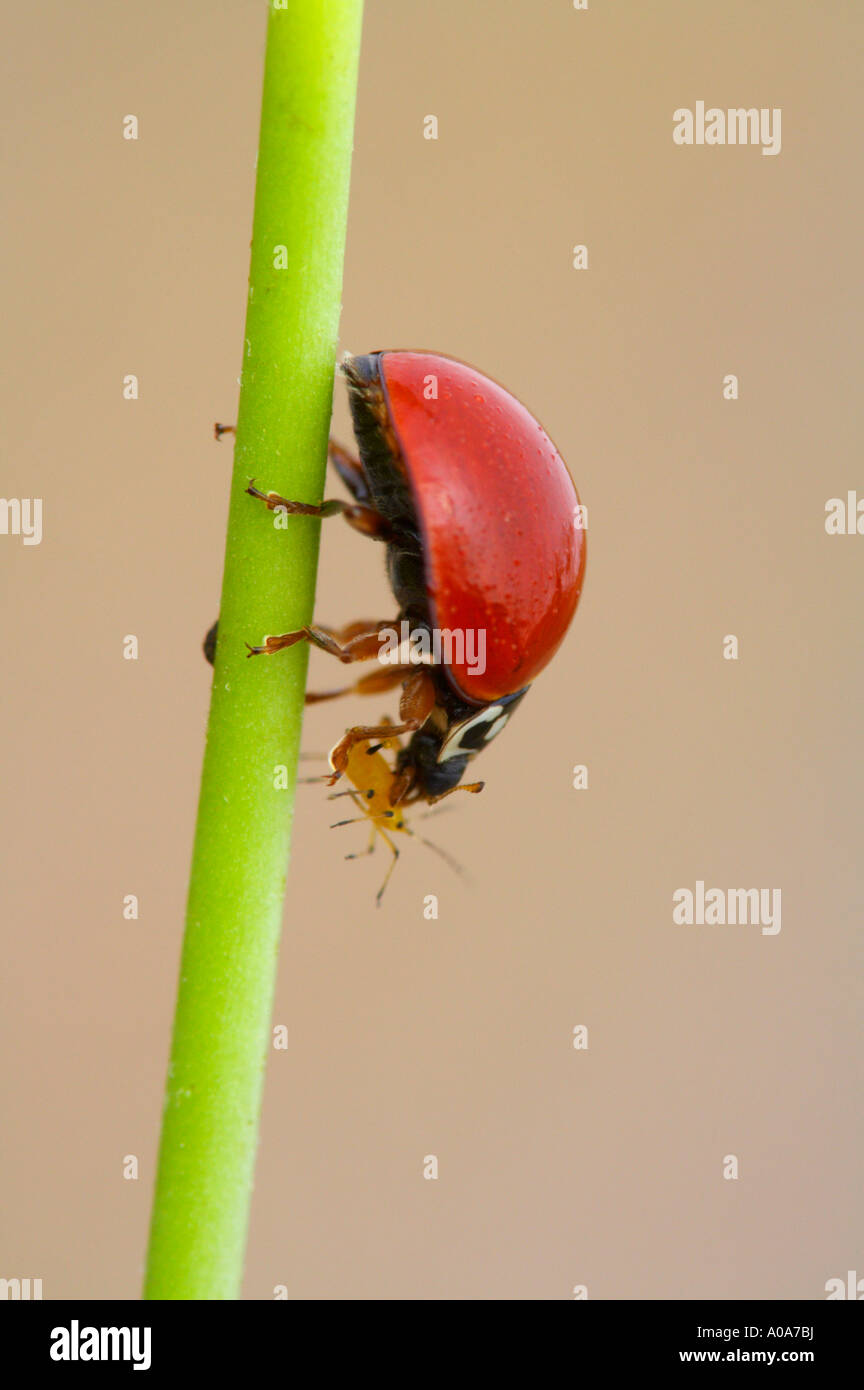 Spottless 'Nine-spotted' Ladybug beetle (Cycloneda munda) on a stem with Aphis nerii. These beetles are aphid preditors and thereby perform a service to humans. It was photographed in the Rio Grand Valley in South Texas. This was photographed with a 16mp digital camera. Stock Photohttps://www.alamy.com/image-license-details/?v=1https://www.alamy.com/spottless-nine-spotted-ladybug-beetle-cycloneda-munda-on-a-stem-with-image9931061.html
Spottless 'Nine-spotted' Ladybug beetle (Cycloneda munda) on a stem with Aphis nerii. These beetles are aphid preditors and thereby perform a service to humans. It was photographed in the Rio Grand Valley in South Texas. This was photographed with a 16mp digital camera. Stock Photohttps://www.alamy.com/image-license-details/?v=1https://www.alamy.com/spottless-nine-spotted-ladybug-beetle-cycloneda-munda-on-a-stem-with-image9931061.htmlRMA0A7BJ–Spottless 'Nine-spotted' Ladybug beetle (Cycloneda munda) on a stem with Aphis nerii. These beetles are aphid preditors and thereby perform a service to humans. It was photographed in the Rio Grand Valley in South Texas. This was photographed with a 16mp digital camera.
 A nine-spotted Ladybird Beetle (Coccinella novemnotata) clings to grass blade on warm spring morning, Denver Colorado US Stock Photohttps://www.alamy.com/image-license-details/?v=1https://www.alamy.com/stock-photo-a-nine-spotted-ladybird-beetle-coccinella-novemnotata-clings-to-grass-27149658.html
A nine-spotted Ladybird Beetle (Coccinella novemnotata) clings to grass blade on warm spring morning, Denver Colorado US Stock Photohttps://www.alamy.com/image-license-details/?v=1https://www.alamy.com/stock-photo-a-nine-spotted-ladybird-beetle-coccinella-novemnotata-clings-to-grass-27149658.htmlRMBG4NJJ–A nine-spotted Ladybird Beetle (Coccinella novemnotata) clings to grass blade on warm spring morning, Denver Colorado US
 Close-up of Nine-Spotted Lady beetle (Coccinella quinquepunctata) flying near flower Stock Photohttps://www.alamy.com/image-license-details/?v=1https://www.alamy.com/stock-photo-close-up-of-nine-spotted-lady-beetle-coccinella-quinquepunctata-flying-11907295.html
Close-up of Nine-Spotted Lady beetle (Coccinella quinquepunctata) flying near flower Stock Photohttps://www.alamy.com/image-license-details/?v=1https://www.alamy.com/stock-photo-close-up-of-nine-spotted-lady-beetle-coccinella-quinquepunctata-flying-11907295.htmlRMA7T91M–Close-up of Nine-Spotted Lady beetle (Coccinella quinquepunctata) flying near flower
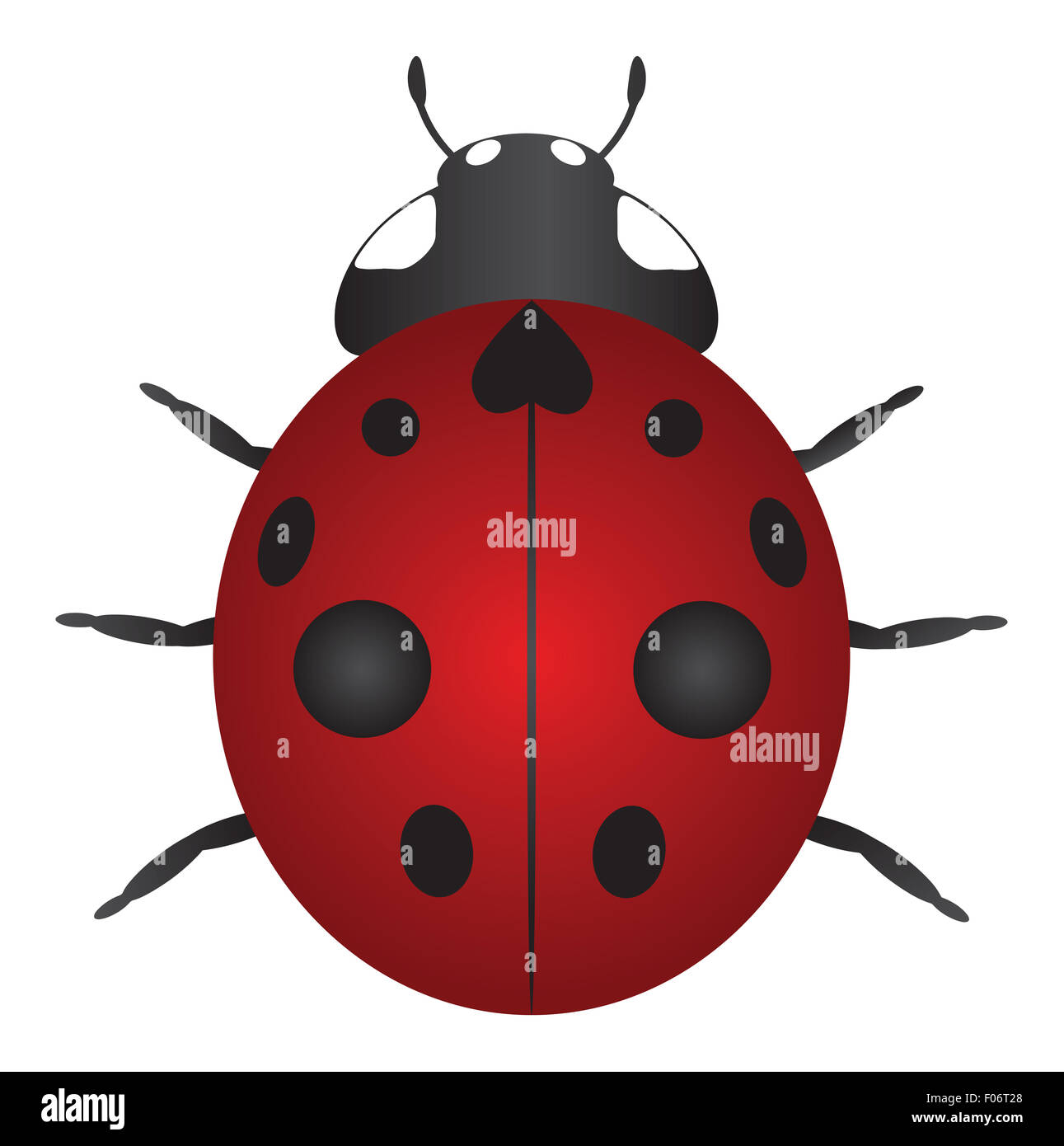 Red Nine Spotted Ladybug Isolated on White Background Color Illustration Stock Photohttps://www.alamy.com/image-license-details/?v=1https://www.alamy.com/stock-photo-red-nine-spotted-ladybug-isolated-on-white-background-color-illustration-86202432.html
Red Nine Spotted Ladybug Isolated on White Background Color Illustration Stock Photohttps://www.alamy.com/image-license-details/?v=1https://www.alamy.com/stock-photo-red-nine-spotted-ladybug-isolated-on-white-background-color-illustration-86202432.htmlRFF06T28–Red Nine Spotted Ladybug Isolated on White Background Color Illustration
 Nine-spotted Lady Beetle (Coccinella novemnotata) Stock Photohttps://www.alamy.com/image-license-details/?v=1https://www.alamy.com/nine-spotted-lady-beetle-coccinella-novemnotata-image637827749.html
Nine-spotted Lady Beetle (Coccinella novemnotata) Stock Photohttps://www.alamy.com/image-license-details/?v=1https://www.alamy.com/nine-spotted-lady-beetle-coccinella-novemnotata-image637827749.htmlRM2S1KFPD–Nine-spotted Lady Beetle (Coccinella novemnotata)
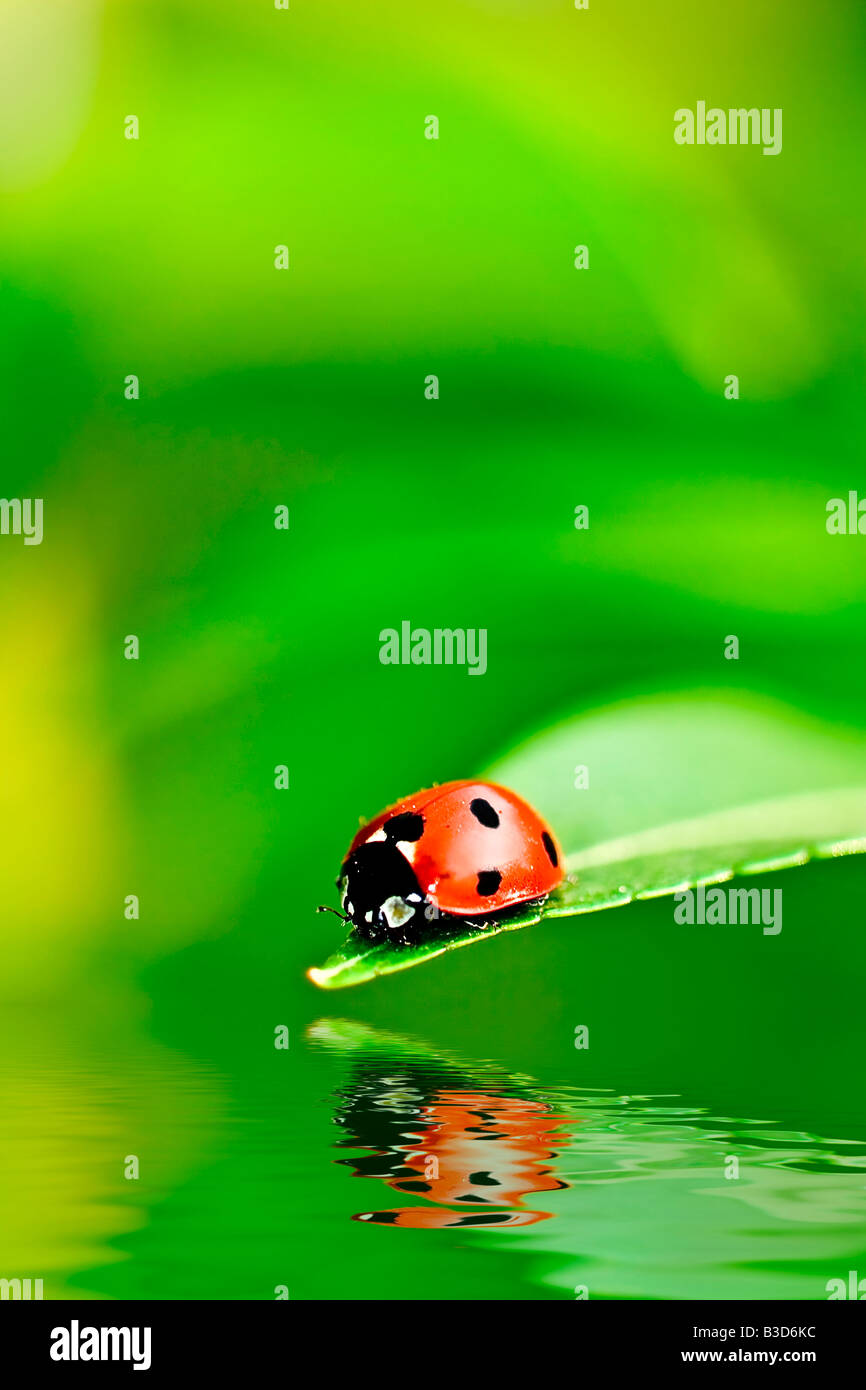 Ladybug on a leaf reflected on water Stock Photohttps://www.alamy.com/image-license-details/?v=1https://www.alamy.com/stock-photo-ladybug-on-a-leaf-reflected-on-water-19344960.html
Ladybug on a leaf reflected on water Stock Photohttps://www.alamy.com/image-license-details/?v=1https://www.alamy.com/stock-photo-ladybug-on-a-leaf-reflected-on-water-19344960.htmlRFB3D6KC–Ladybug on a leaf reflected on water
 . Bulletin. Insects; Insect pests; Entomology; Insects; Insect pests; Entomology. Fig. 39.—The nine-spotted lady-beetle {Coccinella 9-notata), an enemy of the spring grain-aphis: Adult. En- larged. (From Chittenden.) Fig. 40.—The nine- spotted lady-bee- tle {Coccinella 9- notata), an enemy of the spring grain- aphis: Larva. En- larged. (From Chittenden.). Please note that these images are extracted from scanned page images that may have been digitally enhanced for readability - coloration and appearance of these illustrations may not perfectly resemble the original work.. United States. Bureau Stock Photohttps://www.alamy.com/image-license-details/?v=1https://www.alamy.com/bulletin-insects-insect-pests-entomology-insects-insect-pests-entomology-fig-39the-nine-spotted-lady-beetle-coccinella-9-notata-an-enemy-of-the-spring-grain-aphis-adult-en-larged-from-chittenden-fig-40the-nine-spotted-lady-bee-tle-coccinella-9-notata-an-enemy-of-the-spring-grain-aphis-larva-en-larged-from-chittenden-please-note-that-these-images-are-extracted-from-scanned-page-images-that-may-have-been-digitally-enhanced-for-readability-coloration-and-appearance-of-these-illustrations-may-not-perfectly-resemble-the-original-work-united-states-bureau-image234116952.html
. Bulletin. Insects; Insect pests; Entomology; Insects; Insect pests; Entomology. Fig. 39.—The nine-spotted lady-beetle {Coccinella 9-notata), an enemy of the spring grain-aphis: Adult. En- larged. (From Chittenden.) Fig. 40.—The nine- spotted lady-bee- tle {Coccinella 9- notata), an enemy of the spring grain- aphis: Larva. En- larged. (From Chittenden.). Please note that these images are extracted from scanned page images that may have been digitally enhanced for readability - coloration and appearance of these illustrations may not perfectly resemble the original work.. United States. Bureau Stock Photohttps://www.alamy.com/image-license-details/?v=1https://www.alamy.com/bulletin-insects-insect-pests-entomology-insects-insect-pests-entomology-fig-39the-nine-spotted-lady-beetle-coccinella-9-notata-an-enemy-of-the-spring-grain-aphis-adult-en-larged-from-chittenden-fig-40the-nine-spotted-lady-bee-tle-coccinella-9-notata-an-enemy-of-the-spring-grain-aphis-larva-en-larged-from-chittenden-please-note-that-these-images-are-extracted-from-scanned-page-images-that-may-have-been-digitally-enhanced-for-readability-coloration-and-appearance-of-these-illustrations-may-not-perfectly-resemble-the-original-work-united-states-bureau-image234116952.htmlRMRGTXFM–. Bulletin. Insects; Insect pests; Entomology; Insects; Insect pests; Entomology. Fig. 39.—The nine-spotted lady-beetle {Coccinella 9-notata), an enemy of the spring grain-aphis: Adult. En- larged. (From Chittenden.) Fig. 40.—The nine- spotted lady-bee- tle {Coccinella 9- notata), an enemy of the spring grain- aphis: Larva. En- larged. (From Chittenden.). Please note that these images are extracted from scanned page images that may have been digitally enhanced for readability - coloration and appearance of these illustrations may not perfectly resemble the original work.. United States. Bureau
 . Elementary lessons on insects . COLEOPTERA 101 connecting it with the synthorax. By means of the mecha- nism of this joint one of these beetles when placed on its back can spring bodily into the air. The gray "owl beetle" is one of the largest members of the group. The larvae of the group are known as "wire worms." Note especially: (a) The small head and blunt herbiv- orous mouth parts. (b) The fine coloring and sculpturing of the body. , N ,-p,, c c , f t Fig. 40.—The nine-spotted (C) The form Of the rear Ol the pro- lady-bird beetle and its larva. thorax, (d) The groove Stock Photohttps://www.alamy.com/image-license-details/?v=1https://www.alamy.com/elementary-lessons-on-insects-coleoptera-101-connecting-it-with-the-synthorax-by-means-of-the-mecha-nism-of-this-joint-one-of-these-beetles-when-placed-on-its-back-can-spring-bodily-into-the-air-the-gray-quotowl-beetlequot-is-one-of-the-largest-members-of-the-group-the-larvae-of-the-group-are-known-as-quotwire-wormsquot-note-especially-a-the-small-head-and-blunt-herbiv-orous-mouth-parts-b-the-fine-coloring-and-sculpturing-of-the-body-n-p-c-c-f-t-fig-40the-nine-spotted-c-the-form-of-the-rear-ol-the-pro-lady-bird-beetle-and-its-larva-thorax-d-the-groove-image178404106.html
. Elementary lessons on insects . COLEOPTERA 101 connecting it with the synthorax. By means of the mecha- nism of this joint one of these beetles when placed on its back can spring bodily into the air. The gray "owl beetle" is one of the largest members of the group. The larvae of the group are known as "wire worms." Note especially: (a) The small head and blunt herbiv- orous mouth parts. (b) The fine coloring and sculpturing of the body. , N ,-p,, c c , f t Fig. 40.—The nine-spotted (C) The form Of the rear Ol the pro- lady-bird beetle and its larva. thorax, (d) The groove Stock Photohttps://www.alamy.com/image-license-details/?v=1https://www.alamy.com/elementary-lessons-on-insects-coleoptera-101-connecting-it-with-the-synthorax-by-means-of-the-mecha-nism-of-this-joint-one-of-these-beetles-when-placed-on-its-back-can-spring-bodily-into-the-air-the-gray-quotowl-beetlequot-is-one-of-the-largest-members-of-the-group-the-larvae-of-the-group-are-known-as-quotwire-wormsquot-note-especially-a-the-small-head-and-blunt-herbiv-orous-mouth-parts-b-the-fine-coloring-and-sculpturing-of-the-body-n-p-c-c-f-t-fig-40the-nine-spotted-c-the-form-of-the-rear-ol-the-pro-lady-bird-beetle-and-its-larva-thorax-d-the-groove-image178404106.htmlRMMA7076–. Elementary lessons on insects . COLEOPTERA 101 connecting it with the synthorax. By means of the mecha- nism of this joint one of these beetles when placed on its back can spring bodily into the air. The gray "owl beetle" is one of the largest members of the group. The larvae of the group are known as "wire worms." Note especially: (a) The small head and blunt herbiv- orous mouth parts. (b) The fine coloring and sculpturing of the body. , N ,-p,, c c , f t Fig. 40.—The nine-spotted (C) The form Of the rear Ol the pro- lady-bird beetle and its larva. thorax, (d) The groove
![Elementary entomology ([c1912]) Elementary entomology . elementaryentomo00sand Year: [c1912] FIG. 237. The nine-spotted ladybird-beetle (Cocci- nella noveninotata], — adult and larva (After Chittenden) family feed on plant-lice, scales, and other soft-bodied insects, both as adults and as larvae, and may be found wherever their prey becomes abundant. In general the common yellow or red, black-spotted species feed on plant-lice, while the smaller black species, marked with red or yellowish spots, feed on scales. So common are the lady- birds among colonies of plant-lice that they are frequentl Stock Photo Elementary entomology ([c1912]) Elementary entomology . elementaryentomo00sand Year: [c1912] FIG. 237. The nine-spotted ladybird-beetle (Cocci- nella noveninotata], — adult and larva (After Chittenden) family feed on plant-lice, scales, and other soft-bodied insects, both as adults and as larvae, and may be found wherever their prey becomes abundant. In general the common yellow or red, black-spotted species feed on plant-lice, while the smaller black species, marked with red or yellowish spots, feed on scales. So common are the lady- birds among colonies of plant-lice that they are frequentl Stock Photo](https://c8.alamy.com/comp/RYR6YW/elementary-entomology-c1912-elementary-entomology-elementaryentomo00sand-year-c1912-fig-237-the-nine-spotted-ladybird-beetle-cocci-nella-noveninotata-adult-and-larva-after-chittenden-family-feed-on-plant-lice-scales-and-other-soft-bodied-insects-both-as-adults-and-as-larvae-and-may-be-found-wherever-their-prey-becomes-abundant-in-general-the-common-yellow-or-red-black-spotted-species-feed-on-plant-lice-while-the-smaller-black-species-marked-with-red-or-yellowish-spots-feed-on-scales-so-common-are-the-lady-birds-among-colonies-of-plant-lice-that-they-are-frequentl-RYR6YW.jpg) Elementary entomology ([c1912]) Elementary entomology . elementaryentomo00sand Year: [c1912] FIG. 237. The nine-spotted ladybird-beetle (Cocci- nella noveninotata], — adult and larva (After Chittenden) family feed on plant-lice, scales, and other soft-bodied insects, both as adults and as larvae, and may be found wherever their prey becomes abundant. In general the common yellow or red, black-spotted species feed on plant-lice, while the smaller black species, marked with red or yellowish spots, feed on scales. So common are the lady- birds among colonies of plant-lice that they are frequentl Stock Photohttps://www.alamy.com/image-license-details/?v=1https://www.alamy.com/elementary-entomology-c1912-elementary-entomology-elementaryentomo00sand-year-c1912-fig-237-the-nine-spotted-ladybird-beetle-cocci-nella-noveninotata-adult-and-larva-after-chittenden-family-feed-on-plant-lice-scales-and-other-soft-bodied-insects-both-as-adults-and-as-larvae-and-may-be-found-wherever-their-prey-becomes-abundant-in-general-the-common-yellow-or-red-black-spotted-species-feed-on-plant-lice-while-the-smaller-black-species-marked-with-red-or-yellowish-spots-feed-on-scales-so-common-are-the-lady-birds-among-colonies-of-plant-lice-that-they-are-frequentl-image240840877.html
Elementary entomology ([c1912]) Elementary entomology . elementaryentomo00sand Year: [c1912] FIG. 237. The nine-spotted ladybird-beetle (Cocci- nella noveninotata], — adult and larva (After Chittenden) family feed on plant-lice, scales, and other soft-bodied insects, both as adults and as larvae, and may be found wherever their prey becomes abundant. In general the common yellow or red, black-spotted species feed on plant-lice, while the smaller black species, marked with red or yellowish spots, feed on scales. So common are the lady- birds among colonies of plant-lice that they are frequentl Stock Photohttps://www.alamy.com/image-license-details/?v=1https://www.alamy.com/elementary-entomology-c1912-elementary-entomology-elementaryentomo00sand-year-c1912-fig-237-the-nine-spotted-ladybird-beetle-cocci-nella-noveninotata-adult-and-larva-after-chittenden-family-feed-on-plant-lice-scales-and-other-soft-bodied-insects-both-as-adults-and-as-larvae-and-may-be-found-wherever-their-prey-becomes-abundant-in-general-the-common-yellow-or-red-black-spotted-species-feed-on-plant-lice-while-the-smaller-black-species-marked-with-red-or-yellowish-spots-feed-on-scales-so-common-are-the-lady-birds-among-colonies-of-plant-lice-that-they-are-frequentl-image240840877.htmlRMRYR6YW–Elementary entomology ([c1912]) Elementary entomology . elementaryentomo00sand Year: [c1912] FIG. 237. The nine-spotted ladybird-beetle (Cocci- nella noveninotata], — adult and larva (After Chittenden) family feed on plant-lice, scales, and other soft-bodied insects, both as adults and as larvae, and may be found wherever their prey becomes abundant. In general the common yellow or red, black-spotted species feed on plant-lice, while the smaller black species, marked with red or yellowish spots, feed on scales. So common are the lady- birds among colonies of plant-lice that they are frequentl
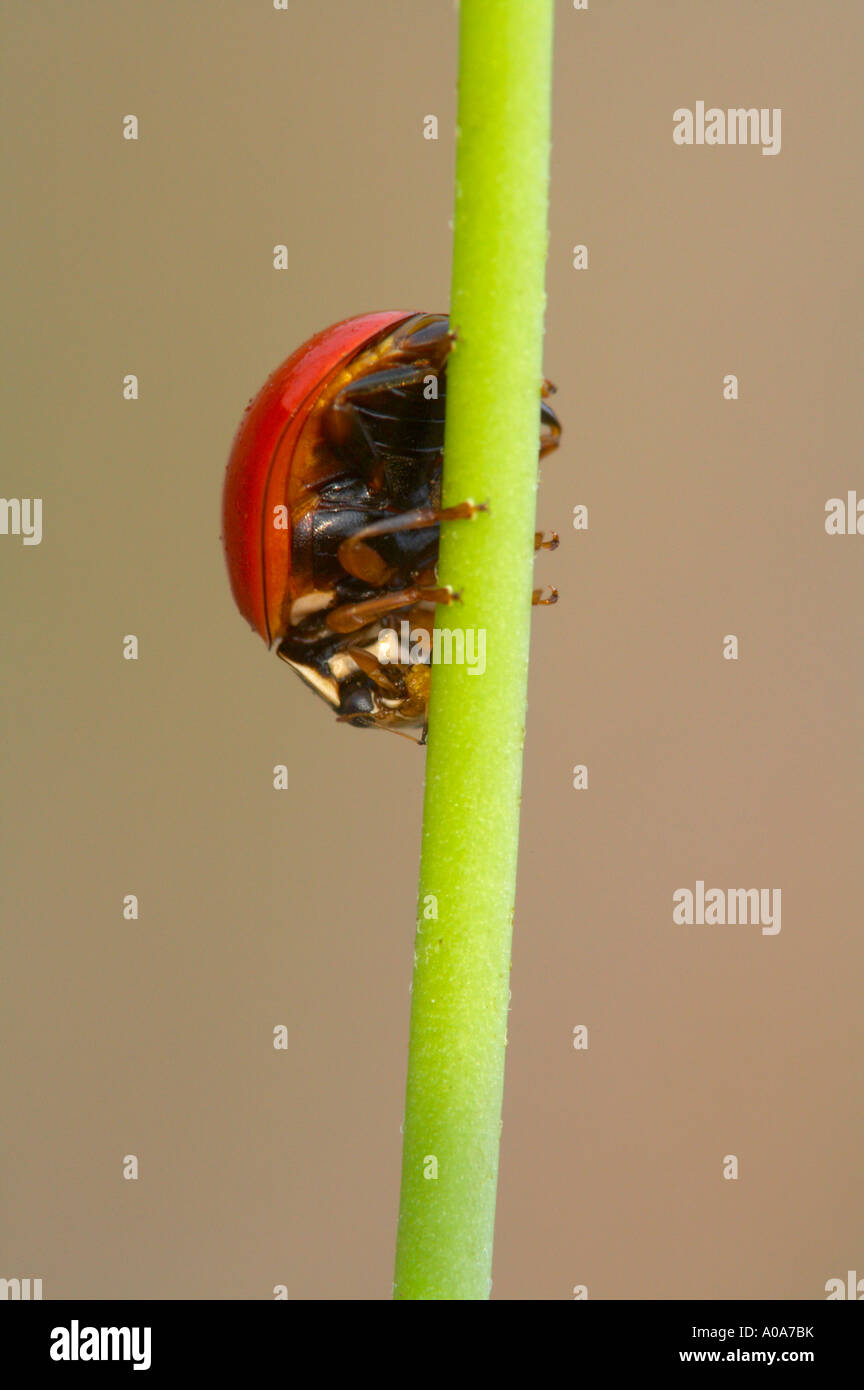 Spottless 'Nine-spotted' Ladybug beetle (Cycloneda munda) on a stem eating Aphis nerii. These beetles are aphid preditors and thereby perform a service to humans. It was photographed in the Rio Grand Valley in South Texas. This was photographed with a 16mp digital camera. Stock Photohttps://www.alamy.com/image-license-details/?v=1https://www.alamy.com/spottless-nine-spotted-ladybug-beetle-cycloneda-munda-on-a-stem-eating-image9931062.html
Spottless 'Nine-spotted' Ladybug beetle (Cycloneda munda) on a stem eating Aphis nerii. These beetles are aphid preditors and thereby perform a service to humans. It was photographed in the Rio Grand Valley in South Texas. This was photographed with a 16mp digital camera. Stock Photohttps://www.alamy.com/image-license-details/?v=1https://www.alamy.com/spottless-nine-spotted-ladybug-beetle-cycloneda-munda-on-a-stem-eating-image9931062.htmlRMA0A7BK–Spottless 'Nine-spotted' Ladybug beetle (Cycloneda munda) on a stem eating Aphis nerii. These beetles are aphid preditors and thereby perform a service to humans. It was photographed in the Rio Grand Valley in South Texas. This was photographed with a 16mp digital camera.
 A nine- spotted Ladybird Beetle (Coccinella novemnotata) clings to grass blade on warm spring morning, Denver Colorado, USA Stock Photohttps://www.alamy.com/image-license-details/?v=1https://www.alamy.com/stock-photo-a-nine-spotted-ladybird-beetle-coccinella-novemnotata-clings-to-grass-20655297.html
A nine- spotted Ladybird Beetle (Coccinella novemnotata) clings to grass blade on warm spring morning, Denver Colorado, USA Stock Photohttps://www.alamy.com/image-license-details/?v=1https://www.alamy.com/stock-photo-a-nine-spotted-ladybird-beetle-coccinella-novemnotata-clings-to-grass-20655297.htmlRMB5GX15–A nine- spotted Ladybird Beetle (Coccinella novemnotata) clings to grass blade on warm spring morning, Denver Colorado, USA
 A nine-spotted Ladybug Beetle (Coccinella novemnotata) resting on grass blade, Colorado US Stock Photohttps://www.alamy.com/image-license-details/?v=1https://www.alamy.com/stock-photo-a-nine-spotted-ladybug-beetle-coccinella-novemnotata-resting-on-grass-20597160.html
A nine-spotted Ladybug Beetle (Coccinella novemnotata) resting on grass blade, Colorado US Stock Photohttps://www.alamy.com/image-license-details/?v=1https://www.alamy.com/stock-photo-a-nine-spotted-ladybug-beetle-coccinella-novemnotata-resting-on-grass-20597160.htmlRMB5E7TT–A nine-spotted Ladybug Beetle (Coccinella novemnotata) resting on grass blade, Colorado US
 Nine-spotted Lady Beetle (Coccinella novemnotata) Stock Photohttps://www.alamy.com/image-license-details/?v=1https://www.alamy.com/nine-spotted-lady-beetle-coccinella-novemnotata-image631982316.html
Nine-spotted Lady Beetle (Coccinella novemnotata) Stock Photohttps://www.alamy.com/image-license-details/?v=1https://www.alamy.com/nine-spotted-lady-beetle-coccinella-novemnotata-image631982316.htmlRM2YM57W0–Nine-spotted Lady Beetle (Coccinella novemnotata)
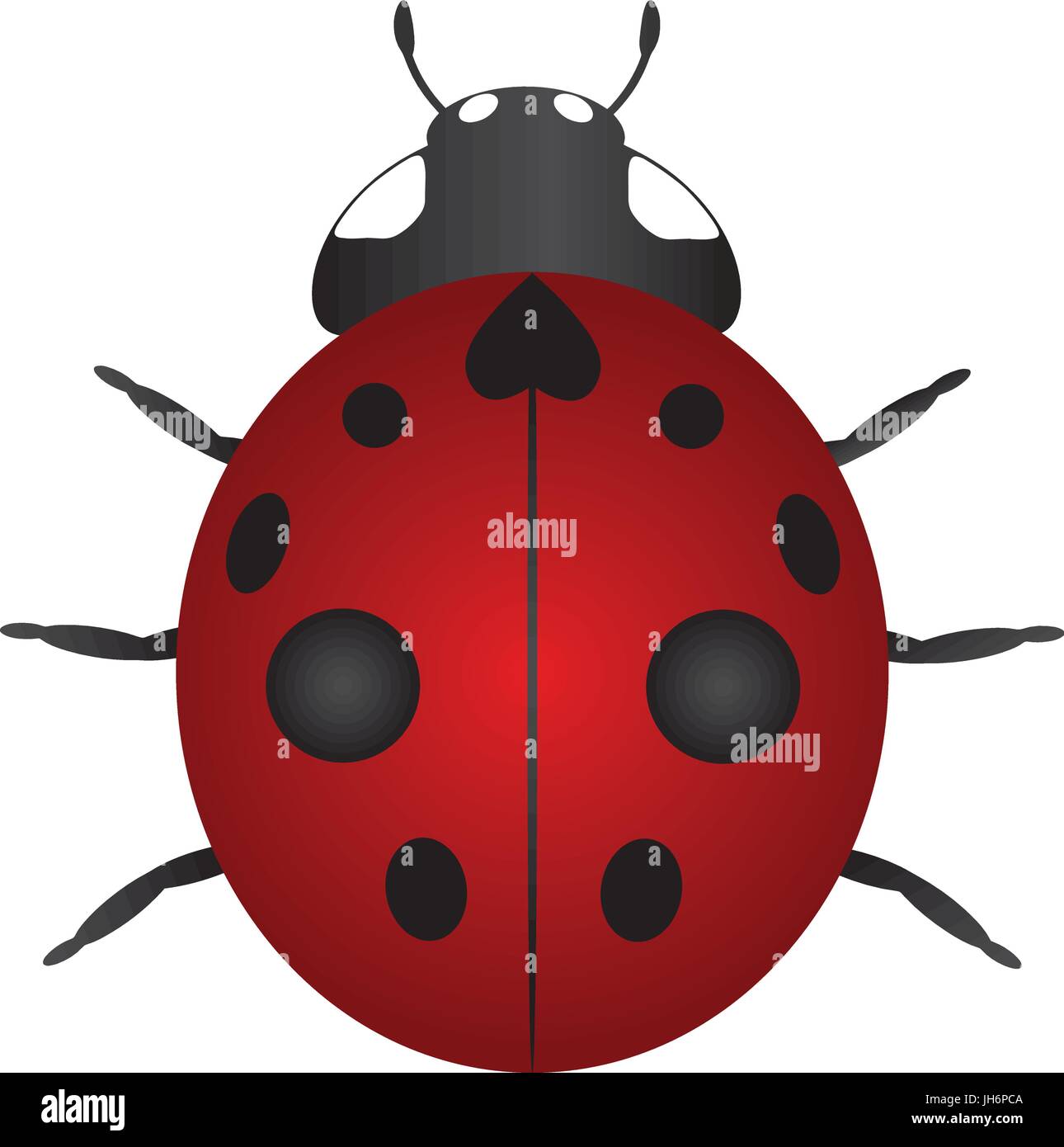 Red Nine Spotted Ladybug Isolated on White Background Color Illustration Stock Vectorhttps://www.alamy.com/image-license-details/?v=1https://www.alamy.com/stock-photo-red-nine-spotted-ladybug-isolated-on-white-background-color-illustration-148281402.html
Red Nine Spotted Ladybug Isolated on White Background Color Illustration Stock Vectorhttps://www.alamy.com/image-license-details/?v=1https://www.alamy.com/stock-photo-red-nine-spotted-ladybug-isolated-on-white-background-color-illustration-148281402.htmlRFJH6PCA–Red Nine Spotted Ladybug Isolated on White Background Color Illustration
 . Bulletin of the U.S. Department of Agriculture. Agriculture. 9-.spotto(l lady-bcotlc (fig. 10) is i)r()b:il)ly most abundant. Its sea- sonal occuiTence doubtless corresponds very closely with that of //. ^ convergens, although our records of the latter have usually been somewhat earlier. One adult individual from infested cotton ate 31 adult red spiders in 24 hours. O c <• a s i o n a 1 observations have been recorded of this Fig. 19.-The nine-spotted lady-beetle {CoccineUa novemno- <'<^f'<"lliellia teeomg On red lata), an enemy of the red spider: Larva at left, adult at spi Stock Photohttps://www.alamy.com/image-license-details/?v=1https://www.alamy.com/bulletin-of-the-us-department-of-agriculture-agriculture-9-spottol-lady-bcotlc-fig-10-is-irbilly-most-abundant-its-sea-sonal-occuitence-doubtless-corresponds-very-closely-with-that-of-convergens-although-our-records-of-the-latter-have-usually-been-somewhat-earlier-one-adult-individual-from-infested-cotton-ate-31-adult-red-spiders-in-24-hours-o-c-lt-a-s-i-o-n-a-1-observations-have-been-recorded-of-this-fig-19-the-nine-spotted-lady-beetle-coccineua-novemno-ltltfltquotlliellia-teeomg-on-red-lata-an-enemy-of-the-red-spider-larva-at-left-adult-at-spi-image233815959.html
. Bulletin of the U.S. Department of Agriculture. Agriculture. 9-.spotto(l lady-bcotlc (fig. 10) is i)r()b:il)ly most abundant. Its sea- sonal occuiTence doubtless corresponds very closely with that of //. ^ convergens, although our records of the latter have usually been somewhat earlier. One adult individual from infested cotton ate 31 adult red spiders in 24 hours. O c <• a s i o n a 1 observations have been recorded of this Fig. 19.-The nine-spotted lady-beetle {CoccineUa novemno- <'<^f'<"lliellia teeomg On red lata), an enemy of the red spider: Larva at left, adult at spi Stock Photohttps://www.alamy.com/image-license-details/?v=1https://www.alamy.com/bulletin-of-the-us-department-of-agriculture-agriculture-9-spottol-lady-bcotlc-fig-10-is-irbilly-most-abundant-its-sea-sonal-occuitence-doubtless-corresponds-very-closely-with-that-of-convergens-although-our-records-of-the-latter-have-usually-been-somewhat-earlier-one-adult-individual-from-infested-cotton-ate-31-adult-red-spiders-in-24-hours-o-c-lt-a-s-i-o-n-a-1-observations-have-been-recorded-of-this-fig-19-the-nine-spotted-lady-beetle-coccineua-novemno-ltltfltquotlliellia-teeomg-on-red-lata-an-enemy-of-the-red-spider-larva-at-left-adult-at-spi-image233815959.htmlRMRGB6HY–. Bulletin of the U.S. Department of Agriculture. Agriculture. 9-.spotto(l lady-bcotlc (fig. 10) is i)r()b:il)ly most abundant. Its sea- sonal occuiTence doubtless corresponds very closely with that of //. ^ convergens, although our records of the latter have usually been somewhat earlier. One adult individual from infested cotton ate 31 adult red spiders in 24 hours. O c <• a s i o n a 1 observations have been recorded of this Fig. 19.-The nine-spotted lady-beetle {CoccineUa novemno- <'<^f'<"lliellia teeomg On red lata), an enemy of the red spider: Larva at left, adult at spi
 . Elementary entomology . Fig. 237. The nine-spotted ladybird-beetle {Cocci- tiella novemnotata), — adult and larva (After Chittenden) family feed on plant-lice, scales, and other soft-bodied insects, both as adults and as larvae, and may be found wherever their prey becomes abundant. In general the common yellow or red, black-spotted species feed on plant-lice, while the smaller black species, marked with red or yellowish spots, feed on scales. So common are the lady- birds among colonies of plant-lice that they are frequently mis- taken as the parents of the aphides, and the misguided grower Stock Photohttps://www.alamy.com/image-license-details/?v=1https://www.alamy.com/elementary-entomology-fig-237-the-nine-spotted-ladybird-beetle-cocci-tiella-novemnotata-adult-and-larva-after-chittenden-family-feed-on-plant-lice-scales-and-other-soft-bodied-insects-both-as-adults-and-as-larvae-and-may-be-found-wherever-their-prey-becomes-abundant-in-general-the-common-yellow-or-red-black-spotted-species-feed-on-plant-lice-while-the-smaller-black-species-marked-with-red-or-yellowish-spots-feed-on-scales-so-common-are-the-lady-birds-among-colonies-of-plant-lice-that-they-are-frequently-mis-taken-as-the-parents-of-the-aphides-and-the-misguided-grower-image178394505.html
. Elementary entomology . Fig. 237. The nine-spotted ladybird-beetle {Cocci- tiella novemnotata), — adult and larva (After Chittenden) family feed on plant-lice, scales, and other soft-bodied insects, both as adults and as larvae, and may be found wherever their prey becomes abundant. In general the common yellow or red, black-spotted species feed on plant-lice, while the smaller black species, marked with red or yellowish spots, feed on scales. So common are the lady- birds among colonies of plant-lice that they are frequently mis- taken as the parents of the aphides, and the misguided grower Stock Photohttps://www.alamy.com/image-license-details/?v=1https://www.alamy.com/elementary-entomology-fig-237-the-nine-spotted-ladybird-beetle-cocci-tiella-novemnotata-adult-and-larva-after-chittenden-family-feed-on-plant-lice-scales-and-other-soft-bodied-insects-both-as-adults-and-as-larvae-and-may-be-found-wherever-their-prey-becomes-abundant-in-general-the-common-yellow-or-red-black-spotted-species-feed-on-plant-lice-while-the-smaller-black-species-marked-with-red-or-yellowish-spots-feed-on-scales-so-common-are-the-lady-birds-among-colonies-of-plant-lice-that-they-are-frequently-mis-taken-as-the-parents-of-the-aphides-and-the-misguided-grower-image178394505.htmlRMMA6G09–. Elementary entomology . Fig. 237. The nine-spotted ladybird-beetle {Cocci- tiella novemnotata), — adult and larva (After Chittenden) family feed on plant-lice, scales, and other soft-bodied insects, both as adults and as larvae, and may be found wherever their prey becomes abundant. In general the common yellow or red, black-spotted species feed on plant-lice, while the smaller black species, marked with red or yellowish spots, feed on scales. So common are the lady- birds among colonies of plant-lice that they are frequently mis- taken as the parents of the aphides, and the misguided grower
![Elementary entomology ([c1912]) Elementary entomology elementaryentomo00sand Year: [c1912] FIG. 237. The nine-spotted ladybird-beetle (Cocci- nella noveninotata], — adult and larva (After Chittenden) family feed on plant-lice, scales, and other soft-bodied insects, both as adults and as larvae, and may be found wherever their prey becomes abundant. In general the common yellow or red, black-spotted species feed on plant-lice, while the smaller black species, marked with red or yellowish spots, feed on scales. So common are the lady- birds among colonies of plant-lice that they are frequently Stock Photo Elementary entomology ([c1912]) Elementary entomology elementaryentomo00sand Year: [c1912] FIG. 237. The nine-spotted ladybird-beetle (Cocci- nella noveninotata], — adult and larva (After Chittenden) family feed on plant-lice, scales, and other soft-bodied insects, both as adults and as larvae, and may be found wherever their prey becomes abundant. In general the common yellow or red, black-spotted species feed on plant-lice, while the smaller black species, marked with red or yellowish spots, feed on scales. So common are the lady- birds among colonies of plant-lice that they are frequently Stock Photo](https://c8.alamy.com/comp/RWPT53/elementary-entomology-c1912-elementary-entomology-elementaryentomo00sand-year-c1912-fig-237-the-nine-spotted-ladybird-beetle-cocci-nella-noveninotata-adult-and-larva-after-chittenden-family-feed-on-plant-lice-scales-and-other-soft-bodied-insects-both-as-adults-and-as-larvae-and-may-be-found-wherever-their-prey-becomes-abundant-in-general-the-common-yellow-or-red-black-spotted-species-feed-on-plant-lice-while-the-smaller-black-species-marked-with-red-or-yellowish-spots-feed-on-scales-so-common-are-the-lady-birds-among-colonies-of-plant-lice-that-they-are-frequently-RWPT53.jpg) Elementary entomology ([c1912]) Elementary entomology elementaryentomo00sand Year: [c1912] FIG. 237. The nine-spotted ladybird-beetle (Cocci- nella noveninotata], — adult and larva (After Chittenden) family feed on plant-lice, scales, and other soft-bodied insects, both as adults and as larvae, and may be found wherever their prey becomes abundant. In general the common yellow or red, black-spotted species feed on plant-lice, while the smaller black species, marked with red or yellowish spots, feed on scales. So common are the lady- birds among colonies of plant-lice that they are frequently Stock Photohttps://www.alamy.com/image-license-details/?v=1https://www.alamy.com/elementary-entomology-c1912-elementary-entomology-elementaryentomo00sand-year-c1912-fig-237-the-nine-spotted-ladybird-beetle-cocci-nella-noveninotata-adult-and-larva-after-chittenden-family-feed-on-plant-lice-scales-and-other-soft-bodied-insects-both-as-adults-and-as-larvae-and-may-be-found-wherever-their-prey-becomes-abundant-in-general-the-common-yellow-or-red-black-spotted-species-feed-on-plant-lice-while-the-smaller-black-species-marked-with-red-or-yellowish-spots-feed-on-scales-so-common-are-the-lady-birds-among-colonies-of-plant-lice-that-they-are-frequently-image239603087.html
Elementary entomology ([c1912]) Elementary entomology elementaryentomo00sand Year: [c1912] FIG. 237. The nine-spotted ladybird-beetle (Cocci- nella noveninotata], — adult and larva (After Chittenden) family feed on plant-lice, scales, and other soft-bodied insects, both as adults and as larvae, and may be found wherever their prey becomes abundant. In general the common yellow or red, black-spotted species feed on plant-lice, while the smaller black species, marked with red or yellowish spots, feed on scales. So common are the lady- birds among colonies of plant-lice that they are frequently Stock Photohttps://www.alamy.com/image-license-details/?v=1https://www.alamy.com/elementary-entomology-c1912-elementary-entomology-elementaryentomo00sand-year-c1912-fig-237-the-nine-spotted-ladybird-beetle-cocci-nella-noveninotata-adult-and-larva-after-chittenden-family-feed-on-plant-lice-scales-and-other-soft-bodied-insects-both-as-adults-and-as-larvae-and-may-be-found-wherever-their-prey-becomes-abundant-in-general-the-common-yellow-or-red-black-spotted-species-feed-on-plant-lice-while-the-smaller-black-species-marked-with-red-or-yellowish-spots-feed-on-scales-so-common-are-the-lady-birds-among-colonies-of-plant-lice-that-they-are-frequently-image239603087.htmlRMRWPT53–Elementary entomology ([c1912]) Elementary entomology elementaryentomo00sand Year: [c1912] FIG. 237. The nine-spotted ladybird-beetle (Cocci- nella noveninotata], — adult and larva (After Chittenden) family feed on plant-lice, scales, and other soft-bodied insects, both as adults and as larvae, and may be found wherever their prey becomes abundant. In general the common yellow or red, black-spotted species feed on plant-lice, while the smaller black species, marked with red or yellowish spots, feed on scales. So common are the lady- birds among colonies of plant-lice that they are frequently
 Nine-spotted Lady Beetle (Coccinella novemnotata) Stock Photohttps://www.alamy.com/image-license-details/?v=1https://www.alamy.com/nine-spotted-lady-beetle-coccinella-novemnotata-image631416471.html
Nine-spotted Lady Beetle (Coccinella novemnotata) Stock Photohttps://www.alamy.com/image-license-details/?v=1https://www.alamy.com/nine-spotted-lady-beetle-coccinella-novemnotata-image631416471.htmlRM2YK7E47–Nine-spotted Lady Beetle (Coccinella novemnotata)
 . Bulletin of the U.S. Department of Agriculture. Agriculture. 58 BULLETIN 416, U. S. DKPARTMENT OF AGRICULTURE.. 9-.spotto(l lady-bcotlc (fig. 10) is i)r()b:il)ly most abundant. Its sea- sonal occuiTence doubtless corresponds very closely with that of //. ^ convergens, although our records of the latter have usually been somewhat earlier. One adult individual from infested cotton ate 31 adult red spiders in 24 hours. O c <• a s i o n a 1 observations have been recorded of this Fig. 19.-The nine-spotted lady-beetle {CoccineUa novemno- <'<^f'<"lliellia teeomg On red lata), an e Stock Photohttps://www.alamy.com/image-license-details/?v=1https://www.alamy.com/bulletin-of-the-us-department-of-agriculture-agriculture-58-bulletin-416-u-s-dkpartment-of-agriculture-9-spottol-lady-bcotlc-fig-10-is-irbilly-most-abundant-its-sea-sonal-occuitence-doubtless-corresponds-very-closely-with-that-of-convergens-although-our-records-of-the-latter-have-usually-been-somewhat-earlier-one-adult-individual-from-infested-cotton-ate-31-adult-red-spiders-in-24-hours-o-c-lt-a-s-i-o-n-a-1-observations-have-been-recorded-of-this-fig-19-the-nine-spotted-lady-beetle-coccineua-novemno-ltltfltquotlliellia-teeomg-on-red-lata-an-e-image233815979.html
. Bulletin of the U.S. Department of Agriculture. Agriculture. 58 BULLETIN 416, U. S. DKPARTMENT OF AGRICULTURE.. 9-.spotto(l lady-bcotlc (fig. 10) is i)r()b:il)ly most abundant. Its sea- sonal occuiTence doubtless corresponds very closely with that of //. ^ convergens, although our records of the latter have usually been somewhat earlier. One adult individual from infested cotton ate 31 adult red spiders in 24 hours. O c <• a s i o n a 1 observations have been recorded of this Fig. 19.-The nine-spotted lady-beetle {CoccineUa novemno- <'<^f'<"lliellia teeomg On red lata), an e Stock Photohttps://www.alamy.com/image-license-details/?v=1https://www.alamy.com/bulletin-of-the-us-department-of-agriculture-agriculture-58-bulletin-416-u-s-dkpartment-of-agriculture-9-spottol-lady-bcotlc-fig-10-is-irbilly-most-abundant-its-sea-sonal-occuitence-doubtless-corresponds-very-closely-with-that-of-convergens-although-our-records-of-the-latter-have-usually-been-somewhat-earlier-one-adult-individual-from-infested-cotton-ate-31-adult-red-spiders-in-24-hours-o-c-lt-a-s-i-o-n-a-1-observations-have-been-recorded-of-this-fig-19-the-nine-spotted-lady-beetle-coccineua-novemno-ltltfltquotlliellia-teeomg-on-red-lata-an-e-image233815979.htmlRMRGB6JK–. Bulletin of the U.S. Department of Agriculture. Agriculture. 58 BULLETIN 416, U. S. DKPARTMENT OF AGRICULTURE.. 9-.spotto(l lady-bcotlc (fig. 10) is i)r()b:il)ly most abundant. Its sea- sonal occuiTence doubtless corresponds very closely with that of //. ^ convergens, although our records of the latter have usually been somewhat earlier. One adult individual from infested cotton ate 31 adult red spiders in 24 hours. O c <• a s i o n a 1 observations have been recorded of this Fig. 19.-The nine-spotted lady-beetle {CoccineUa novemno- <'<^f'<"lliellia teeomg On red lata), an e
![. Elementary entomology . FIG. 237. The nine-spotted ladybird-beetle (Cocci- nella noveninotata], — adult and larva (After Chittenden) family feed on plant-lice, scales, and other soft-bodied insects, both as adults and as larvae, and may be found wherever their prey becomes abundant. In general the common yellow or red, black-spotted species feed on plant-lice, while the smaller black species, marked with red or yellowish spots, feed on scales. So common are the lady- birds among colonies of plant-lice that they are frequently mis- ^^ ^ ^ of the aphides, and the misguided grower carefully pic Stock Photo . Elementary entomology . FIG. 237. The nine-spotted ladybird-beetle (Cocci- nella noveninotata], — adult and larva (After Chittenden) family feed on plant-lice, scales, and other soft-bodied insects, both as adults and as larvae, and may be found wherever their prey becomes abundant. In general the common yellow or red, black-spotted species feed on plant-lice, while the smaller black species, marked with red or yellowish spots, feed on scales. So common are the lady- birds among colonies of plant-lice that they are frequently mis- ^^ ^ ^ of the aphides, and the misguided grower carefully pic Stock Photo](https://c8.alamy.com/comp/MA7147/elementary-entomology-fig-237-the-nine-spotted-ladybird-beetle-cocci-nella-noveninotata-adult-and-larva-after-chittenden-family-feed-on-plant-lice-scales-and-other-soft-bodied-insects-both-as-adults-and-as-larvae-and-may-be-found-wherever-their-prey-becomes-abundant-in-general-the-common-yellow-or-red-black-spotted-species-feed-on-plant-lice-while-the-smaller-black-species-marked-with-red-or-yellowish-spots-feed-on-scales-so-common-are-the-lady-birds-among-colonies-of-plant-lice-that-they-are-frequently-mis-of-the-aphides-and-the-misguided-grower-carefully-pic-MA7147.jpg) . Elementary entomology . FIG. 237. The nine-spotted ladybird-beetle (Cocci- nella noveninotata], — adult and larva (After Chittenden) family feed on plant-lice, scales, and other soft-bodied insects, both as adults and as larvae, and may be found wherever their prey becomes abundant. In general the common yellow or red, black-spotted species feed on plant-lice, while the smaller black species, marked with red or yellowish spots, feed on scales. So common are the lady- birds among colonies of plant-lice that they are frequently mis- ^^ ^ ^ of the aphides, and the misguided grower carefully pic Stock Photohttps://www.alamy.com/image-license-details/?v=1https://www.alamy.com/elementary-entomology-fig-237-the-nine-spotted-ladybird-beetle-cocci-nella-noveninotata-adult-and-larva-after-chittenden-family-feed-on-plant-lice-scales-and-other-soft-bodied-insects-both-as-adults-and-as-larvae-and-may-be-found-wherever-their-prey-becomes-abundant-in-general-the-common-yellow-or-red-black-spotted-species-feed-on-plant-lice-while-the-smaller-black-species-marked-with-red-or-yellowish-spots-feed-on-scales-so-common-are-the-lady-birds-among-colonies-of-plant-lice-that-they-are-frequently-mis-of-the-aphides-and-the-misguided-grower-carefully-pic-image178404807.html
. Elementary entomology . FIG. 237. The nine-spotted ladybird-beetle (Cocci- nella noveninotata], — adult and larva (After Chittenden) family feed on plant-lice, scales, and other soft-bodied insects, both as adults and as larvae, and may be found wherever their prey becomes abundant. In general the common yellow or red, black-spotted species feed on plant-lice, while the smaller black species, marked with red or yellowish spots, feed on scales. So common are the lady- birds among colonies of plant-lice that they are frequently mis- ^^ ^ ^ of the aphides, and the misguided grower carefully pic Stock Photohttps://www.alamy.com/image-license-details/?v=1https://www.alamy.com/elementary-entomology-fig-237-the-nine-spotted-ladybird-beetle-cocci-nella-noveninotata-adult-and-larva-after-chittenden-family-feed-on-plant-lice-scales-and-other-soft-bodied-insects-both-as-adults-and-as-larvae-and-may-be-found-wherever-their-prey-becomes-abundant-in-general-the-common-yellow-or-red-black-spotted-species-feed-on-plant-lice-while-the-smaller-black-species-marked-with-red-or-yellowish-spots-feed-on-scales-so-common-are-the-lady-birds-among-colonies-of-plant-lice-that-they-are-frequently-mis-of-the-aphides-and-the-misguided-grower-carefully-pic-image178404807.htmlRMMA7147–. Elementary entomology . FIG. 237. The nine-spotted ladybird-beetle (Cocci- nella noveninotata], — adult and larva (After Chittenden) family feed on plant-lice, scales, and other soft-bodied insects, both as adults and as larvae, and may be found wherever their prey becomes abundant. In general the common yellow or red, black-spotted species feed on plant-lice, while the smaller black species, marked with red or yellowish spots, feed on scales. So common are the lady- birds among colonies of plant-lice that they are frequently mis- ^^ ^ ^ of the aphides, and the misguided grower carefully pic
 Nine-spotted Lady Beetle (Coccinella novemnotata) Stock Photohttps://www.alamy.com/image-license-details/?v=1https://www.alamy.com/nine-spotted-lady-beetle-coccinella-novemnotata-image631999151.html
Nine-spotted Lady Beetle (Coccinella novemnotata) Stock Photohttps://www.alamy.com/image-license-details/?v=1https://www.alamy.com/nine-spotted-lady-beetle-coccinella-novemnotata-image631999151.htmlRM2YM61A7–Nine-spotted Lady Beetle (Coccinella novemnotata)
 . Bulletin. Insects; Insect pests; Entomology; Insects; Insect pests; Entomology. a b Fig. 9.—Nine-spotted lady-beetle (Coccinella 9-notata): a, Adult; b, L.rva. Much enlarged. (From Chit- tenden.) The invertebrate enemies are divided between native species and those imported from Italy, the native being largely predaceous and the foreign all parasitic. Besides these, there are two fungous enemies, both of which affect the insect to a greater or less degree. Invertebrates . When a foreign species, like the alfalfa weevil, is introduced into a new country, some time is required for the native i Stock Photohttps://www.alamy.com/image-license-details/?v=1https://www.alamy.com/bulletin-insects-insect-pests-entomology-insects-insect-pests-entomology-a-b-fig-9nine-spotted-lady-beetle-coccinella-9-notata-a-adult-b-lrva-much-enlarged-from-chit-tenden-the-invertebrate-enemies-are-divided-between-native-species-and-those-imported-from-italy-the-native-being-largely-predaceous-and-the-foreign-all-parasitic-besides-these-there-are-two-fungous-enemies-both-of-which-affect-the-insect-to-a-greater-or-less-degree-invertebrates-when-a-foreign-species-like-the-alfalfa-weevil-is-introduced-into-a-new-country-some-time-is-required-for-the-native-i-image234102960.html
. Bulletin. Insects; Insect pests; Entomology; Insects; Insect pests; Entomology. a b Fig. 9.—Nine-spotted lady-beetle (Coccinella 9-notata): a, Adult; b, L.rva. Much enlarged. (From Chit- tenden.) The invertebrate enemies are divided between native species and those imported from Italy, the native being largely predaceous and the foreign all parasitic. Besides these, there are two fungous enemies, both of which affect the insect to a greater or less degree. Invertebrates . When a foreign species, like the alfalfa weevil, is introduced into a new country, some time is required for the native i Stock Photohttps://www.alamy.com/image-license-details/?v=1https://www.alamy.com/bulletin-insects-insect-pests-entomology-insects-insect-pests-entomology-a-b-fig-9nine-spotted-lady-beetle-coccinella-9-notata-a-adult-b-lrva-much-enlarged-from-chit-tenden-the-invertebrate-enemies-are-divided-between-native-species-and-those-imported-from-italy-the-native-being-largely-predaceous-and-the-foreign-all-parasitic-besides-these-there-are-two-fungous-enemies-both-of-which-affect-the-insect-to-a-greater-or-less-degree-invertebrates-when-a-foreign-species-like-the-alfalfa-weevil-is-introduced-into-a-new-country-some-time-is-required-for-the-native-i-image234102960.htmlRMRGT8M0–. Bulletin. Insects; Insect pests; Entomology; Insects; Insect pests; Entomology. a b Fig. 9.—Nine-spotted lady-beetle (Coccinella 9-notata): a, Adult; b, L.rva. Much enlarged. (From Chit- tenden.) The invertebrate enemies are divided between native species and those imported from Italy, the native being largely predaceous and the foreign all parasitic. Besides these, there are two fungous enemies, both of which affect the insect to a greater or less degree. Invertebrates . When a foreign species, like the alfalfa weevil, is introduced into a new country, some time is required for the native i
 Nine-spotted Lady Beetle (Coccinella novemnotata) Stock Photohttps://www.alamy.com/image-license-details/?v=1https://www.alamy.com/nine-spotted-lady-beetle-coccinella-novemnotata-image631486322.html
Nine-spotted Lady Beetle (Coccinella novemnotata) Stock Photohttps://www.alamy.com/image-license-details/?v=1https://www.alamy.com/nine-spotted-lady-beetle-coccinella-novemnotata-image631486322.htmlRM2YKAK6X–Nine-spotted Lady Beetle (Coccinella novemnotata)
 . Bulletin. Insects; Insect pests; Entomology; Insects; Insect pests; Entomology. NATURAL ENEMIES. 31. a b Fig. 9.—Nine-spotted lady-beetle (Coccinella 9-notata): a, Adult; b, L.rva. Much enlarged. (From Chit- tenden.) The invertebrate enemies are divided between native species and those imported from Italy, the native being largely predaceous and the foreign all parasitic. Besides these, there are two fungous enemies, both of which affect the insect to a greater or less degree. Invertebrates . When a foreign species, like the alfalfa weevil, is introduced into a new country, some time is requ Stock Photohttps://www.alamy.com/image-license-details/?v=1https://www.alamy.com/bulletin-insects-insect-pests-entomology-insects-insect-pests-entomology-natural-enemies-31-a-b-fig-9nine-spotted-lady-beetle-coccinella-9-notata-a-adult-b-lrva-much-enlarged-from-chit-tenden-the-invertebrate-enemies-are-divided-between-native-species-and-those-imported-from-italy-the-native-being-largely-predaceous-and-the-foreign-all-parasitic-besides-these-there-are-two-fungous-enemies-both-of-which-affect-the-insect-to-a-greater-or-less-degree-invertebrates-when-a-foreign-species-like-the-alfalfa-weevil-is-introduced-into-a-new-country-some-time-is-requ-image234102973.html
. Bulletin. Insects; Insect pests; Entomology; Insects; Insect pests; Entomology. NATURAL ENEMIES. 31. a b Fig. 9.—Nine-spotted lady-beetle (Coccinella 9-notata): a, Adult; b, L.rva. Much enlarged. (From Chit- tenden.) The invertebrate enemies are divided between native species and those imported from Italy, the native being largely predaceous and the foreign all parasitic. Besides these, there are two fungous enemies, both of which affect the insect to a greater or less degree. Invertebrates . When a foreign species, like the alfalfa weevil, is introduced into a new country, some time is requ Stock Photohttps://www.alamy.com/image-license-details/?v=1https://www.alamy.com/bulletin-insects-insect-pests-entomology-insects-insect-pests-entomology-natural-enemies-31-a-b-fig-9nine-spotted-lady-beetle-coccinella-9-notata-a-adult-b-lrva-much-enlarged-from-chit-tenden-the-invertebrate-enemies-are-divided-between-native-species-and-those-imported-from-italy-the-native-being-largely-predaceous-and-the-foreign-all-parasitic-besides-these-there-are-two-fungous-enemies-both-of-which-affect-the-insect-to-a-greater-or-less-degree-invertebrates-when-a-foreign-species-like-the-alfalfa-weevil-is-introduced-into-a-new-country-some-time-is-requ-image234102973.htmlRMRGT8MD–. Bulletin. Insects; Insect pests; Entomology; Insects; Insect pests; Entomology. NATURAL ENEMIES. 31. a b Fig. 9.—Nine-spotted lady-beetle (Coccinella 9-notata): a, Adult; b, L.rva. Much enlarged. (From Chit- tenden.) The invertebrate enemies are divided between native species and those imported from Italy, the native being largely predaceous and the foreign all parasitic. Besides these, there are two fungous enemies, both of which affect the insect to a greater or less degree. Invertebrates . When a foreign species, like the alfalfa weevil, is introduced into a new country, some time is requ
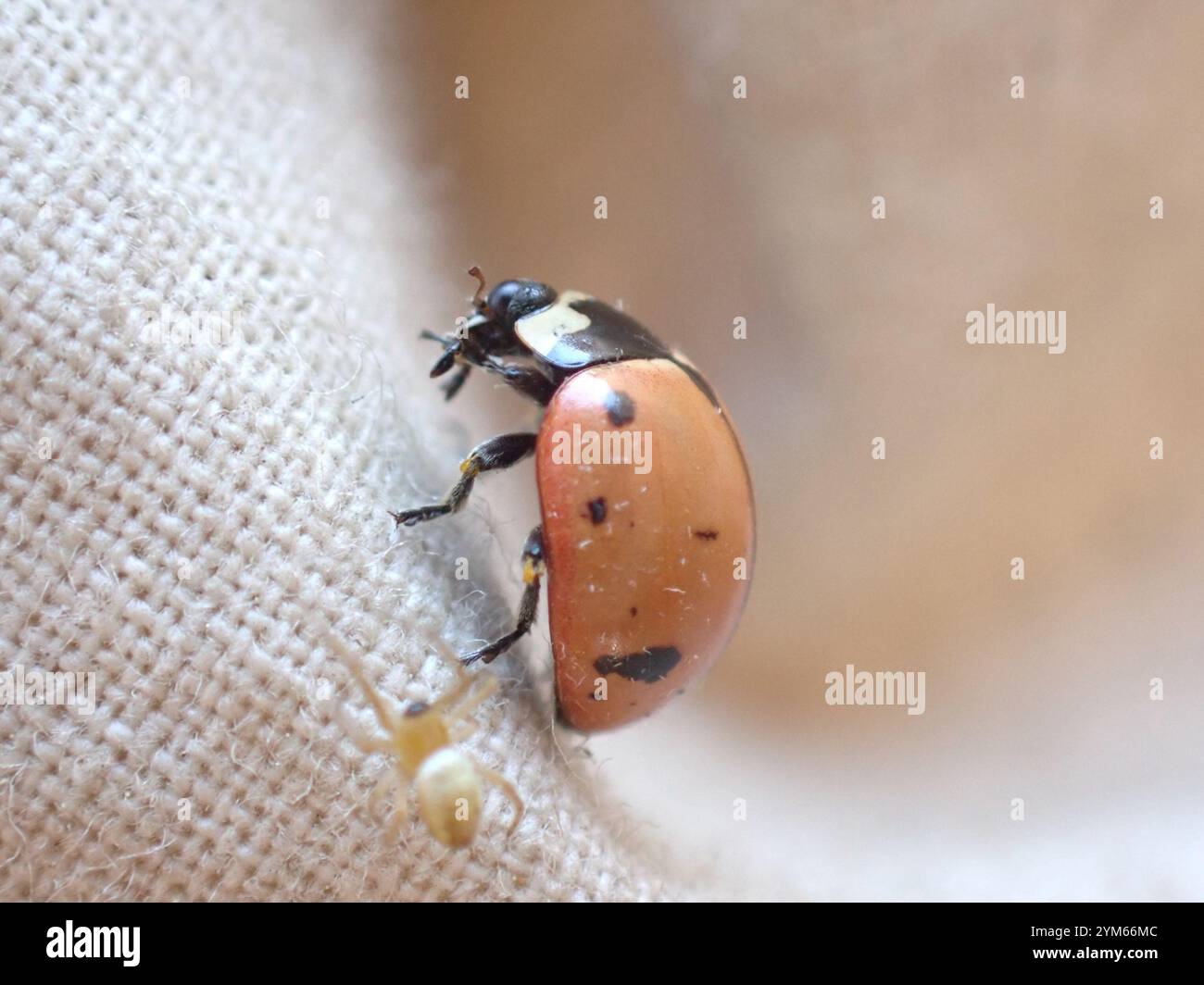 Nine-spotted Lady Beetle (Coccinella novemnotata) Stock Photohttps://www.alamy.com/image-license-details/?v=1https://www.alamy.com/nine-spotted-lady-beetle-coccinella-novemnotata-image632003356.html
Nine-spotted Lady Beetle (Coccinella novemnotata) Stock Photohttps://www.alamy.com/image-license-details/?v=1https://www.alamy.com/nine-spotted-lady-beetle-coccinella-novemnotata-image632003356.htmlRM2YM66MC–Nine-spotted Lady Beetle (Coccinella novemnotata)
 . Elementary lessons on insects. Insects. COLEOPTERA 101 connecting it with the synthorax. By means of the mecha- nism of this joint one of these beetles when placed on its back can spring bodily into the air. The gray "owl beetle" is one of the largest members of the group. The larvae of the group are known as "wire worms." Note especially: (a) The small head and blunt herbiv- orous mouth parts. (b) The fine coloring and sculpturing of the body. , N ,-p,, c c , f t Fig. 40.—The nine-spotted (C) The form Of the rear Ol the pro- lady-bird beetle and its larva. thorax, (d) Th Stock Photohttps://www.alamy.com/image-license-details/?v=1https://www.alamy.com/elementary-lessons-on-insects-insects-coleoptera-101-connecting-it-with-the-synthorax-by-means-of-the-mecha-nism-of-this-joint-one-of-these-beetles-when-placed-on-its-back-can-spring-bodily-into-the-air-the-gray-quotowl-beetlequot-is-one-of-the-largest-members-of-the-group-the-larvae-of-the-group-are-known-as-quotwire-wormsquot-note-especially-a-the-small-head-and-blunt-herbiv-orous-mouth-parts-b-the-fine-coloring-and-sculpturing-of-the-body-n-p-c-c-f-t-fig-40the-nine-spotted-c-the-form-of-the-rear-ol-the-pro-lady-bird-beetle-and-its-larva-thorax-d-th-image231789286.html
. Elementary lessons on insects. Insects. COLEOPTERA 101 connecting it with the synthorax. By means of the mecha- nism of this joint one of these beetles when placed on its back can spring bodily into the air. The gray "owl beetle" is one of the largest members of the group. The larvae of the group are known as "wire worms." Note especially: (a) The small head and blunt herbiv- orous mouth parts. (b) The fine coloring and sculpturing of the body. , N ,-p,, c c , f t Fig. 40.—The nine-spotted (C) The form Of the rear Ol the pro- lady-bird beetle and its larva. thorax, (d) Th Stock Photohttps://www.alamy.com/image-license-details/?v=1https://www.alamy.com/elementary-lessons-on-insects-insects-coleoptera-101-connecting-it-with-the-synthorax-by-means-of-the-mecha-nism-of-this-joint-one-of-these-beetles-when-placed-on-its-back-can-spring-bodily-into-the-air-the-gray-quotowl-beetlequot-is-one-of-the-largest-members-of-the-group-the-larvae-of-the-group-are-known-as-quotwire-wormsquot-note-especially-a-the-small-head-and-blunt-herbiv-orous-mouth-parts-b-the-fine-coloring-and-sculpturing-of-the-body-n-p-c-c-f-t-fig-40the-nine-spotted-c-the-form-of-the-rear-ol-the-pro-lady-bird-beetle-and-its-larva-thorax-d-th-image231789286.htmlRMRD2WGP–. Elementary lessons on insects. Insects. COLEOPTERA 101 connecting it with the synthorax. By means of the mecha- nism of this joint one of these beetles when placed on its back can spring bodily into the air. The gray "owl beetle" is one of the largest members of the group. The larvae of the group are known as "wire worms." Note especially: (a) The small head and blunt herbiv- orous mouth parts. (b) The fine coloring and sculpturing of the body. , N ,-p,, c c , f t Fig. 40.—The nine-spotted (C) The form Of the rear Ol the pro- lady-bird beetle and its larva. thorax, (d) Th
 Nine-spotted Lady Beetle (Coccinella novemnotata) Stock Photohttps://www.alamy.com/image-license-details/?v=1https://www.alamy.com/nine-spotted-lady-beetle-coccinella-novemnotata-image631450267.html
Nine-spotted Lady Beetle (Coccinella novemnotata) Stock Photohttps://www.alamy.com/image-license-details/?v=1https://www.alamy.com/nine-spotted-lady-beetle-coccinella-novemnotata-image631450267.htmlRM2YK9177–Nine-spotted Lady Beetle (Coccinella novemnotata)
 . The American boys' book of bugs, butterflies and beetles. Insects. Lady-l)ugs, Lady-birds 269 beetle and remember that the gentlemen beetles in this case are always known as lady-bugs too. They are probably suffragettes, and if they are they are militants. Among the scientists they are known as one-spotted lady-bugs, two-spotted lady-bugs, or nine-spotted lady-bugs, but of course scientists do not call them bugs; they have scientific names sug- gested by the number of spots on the beetle's back. The lady-bugs always appear to be gentle little. 2^1 creatures but that is because we are so big Stock Photohttps://www.alamy.com/image-license-details/?v=1https://www.alamy.com/the-american-boys-book-of-bugs-butterflies-and-beetles-insects-lady-lugs-lady-birds-269-beetle-and-remember-that-the-gentlemen-beetles-in-this-case-are-always-known-as-lady-bugs-too-they-are-probably-suffragettes-and-if-they-are-they-are-militants-among-the-scientists-they-are-known-as-one-spotted-lady-bugs-two-spotted-lady-bugs-or-nine-spotted-lady-bugs-but-of-course-scientists-do-not-call-them-bugs-they-have-scientific-names-sug-gested-by-the-number-of-spots-on-the-beetles-back-the-lady-bugs-always-appear-to-be-gentle-little-21-creatures-but-that-is-because-we-are-so-big-image237607609.html
. The American boys' book of bugs, butterflies and beetles. Insects. Lady-l)ugs, Lady-birds 269 beetle and remember that the gentlemen beetles in this case are always known as lady-bugs too. They are probably suffragettes, and if they are they are militants. Among the scientists they are known as one-spotted lady-bugs, two-spotted lady-bugs, or nine-spotted lady-bugs, but of course scientists do not call them bugs; they have scientific names sug- gested by the number of spots on the beetle's back. The lady-bugs always appear to be gentle little. 2^1 creatures but that is because we are so big Stock Photohttps://www.alamy.com/image-license-details/?v=1https://www.alamy.com/the-american-boys-book-of-bugs-butterflies-and-beetles-insects-lady-lugs-lady-birds-269-beetle-and-remember-that-the-gentlemen-beetles-in-this-case-are-always-known-as-lady-bugs-too-they-are-probably-suffragettes-and-if-they-are-they-are-militants-among-the-scientists-they-are-known-as-one-spotted-lady-bugs-two-spotted-lady-bugs-or-nine-spotted-lady-bugs-but-of-course-scientists-do-not-call-them-bugs-they-have-scientific-names-sug-gested-by-the-number-of-spots-on-the-beetles-back-the-lady-bugs-always-appear-to-be-gentle-little-21-creatures-but-that-is-because-we-are-so-big-image237607609.htmlRMRPFXX1–. The American boys' book of bugs, butterflies and beetles. Insects. Lady-l)ugs, Lady-birds 269 beetle and remember that the gentlemen beetles in this case are always known as lady-bugs too. They are probably suffragettes, and if they are they are militants. Among the scientists they are known as one-spotted lady-bugs, two-spotted lady-bugs, or nine-spotted lady-bugs, but of course scientists do not call them bugs; they have scientific names sug- gested by the number of spots on the beetle's back. The lady-bugs always appear to be gentle little. 2^1 creatures but that is because we are so big
 Nine-spotted Lady Beetle (Coccinella novemnotata) Stock Photohttps://www.alamy.com/image-license-details/?v=1https://www.alamy.com/nine-spotted-lady-beetle-coccinella-novemnotata-image631972215.html
Nine-spotted Lady Beetle (Coccinella novemnotata) Stock Photohttps://www.alamy.com/image-license-details/?v=1https://www.alamy.com/nine-spotted-lady-beetle-coccinella-novemnotata-image631972215.htmlRM2YM4R07–Nine-spotted Lady Beetle (Coccinella novemnotata)
 . Elementary entomology. Entomology. Fig. 237. The nine-spotted ladybird-beetle {Cocci- tiella novemnotata), — adult and larva (After Chittenden) family feed on plant-lice, scales, and other soft-bodied insects, both as adults and as larvae, and may be found wherever their prey becomes abundant. In general the common yellow or red, black-spotted species feed on plant-lice, while the smaller black species, marked with red or yellowish spots, feed on scales. So common are the lady- birds among colonies of plant-lice that they are frequently mis- taken as the parents of the aphides, and the misgu Stock Photohttps://www.alamy.com/image-license-details/?v=1https://www.alamy.com/elementary-entomology-entomology-fig-237-the-nine-spotted-ladybird-beetle-cocci-tiella-novemnotata-adult-and-larva-after-chittenden-family-feed-on-plant-lice-scales-and-other-soft-bodied-insects-both-as-adults-and-as-larvae-and-may-be-found-wherever-their-prey-becomes-abundant-in-general-the-common-yellow-or-red-black-spotted-species-feed-on-plant-lice-while-the-smaller-black-species-marked-with-red-or-yellowish-spots-feed-on-scales-so-common-are-the-lady-birds-among-colonies-of-plant-lice-that-they-are-frequently-mis-taken-as-the-parents-of-the-aphides-and-the-misgu-image231831184.html
. Elementary entomology. Entomology. Fig. 237. The nine-spotted ladybird-beetle {Cocci- tiella novemnotata), — adult and larva (After Chittenden) family feed on plant-lice, scales, and other soft-bodied insects, both as adults and as larvae, and may be found wherever their prey becomes abundant. In general the common yellow or red, black-spotted species feed on plant-lice, while the smaller black species, marked with red or yellowish spots, feed on scales. So common are the lady- birds among colonies of plant-lice that they are frequently mis- taken as the parents of the aphides, and the misgu Stock Photohttps://www.alamy.com/image-license-details/?v=1https://www.alamy.com/elementary-entomology-entomology-fig-237-the-nine-spotted-ladybird-beetle-cocci-tiella-novemnotata-adult-and-larva-after-chittenden-family-feed-on-plant-lice-scales-and-other-soft-bodied-insects-both-as-adults-and-as-larvae-and-may-be-found-wherever-their-prey-becomes-abundant-in-general-the-common-yellow-or-red-black-spotted-species-feed-on-plant-lice-while-the-smaller-black-species-marked-with-red-or-yellowish-spots-feed-on-scales-so-common-are-the-lady-birds-among-colonies-of-plant-lice-that-they-are-frequently-mis-taken-as-the-parents-of-the-aphides-and-the-misgu-image231831184.htmlRMRD4R14–. Elementary entomology. Entomology. Fig. 237. The nine-spotted ladybird-beetle {Cocci- tiella novemnotata), — adult and larva (After Chittenden) family feed on plant-lice, scales, and other soft-bodied insects, both as adults and as larvae, and may be found wherever their prey becomes abundant. In general the common yellow or red, black-spotted species feed on plant-lice, while the smaller black species, marked with red or yellowish spots, feed on scales. So common are the lady- birds among colonies of plant-lice that they are frequently mis- taken as the parents of the aphides, and the misgu
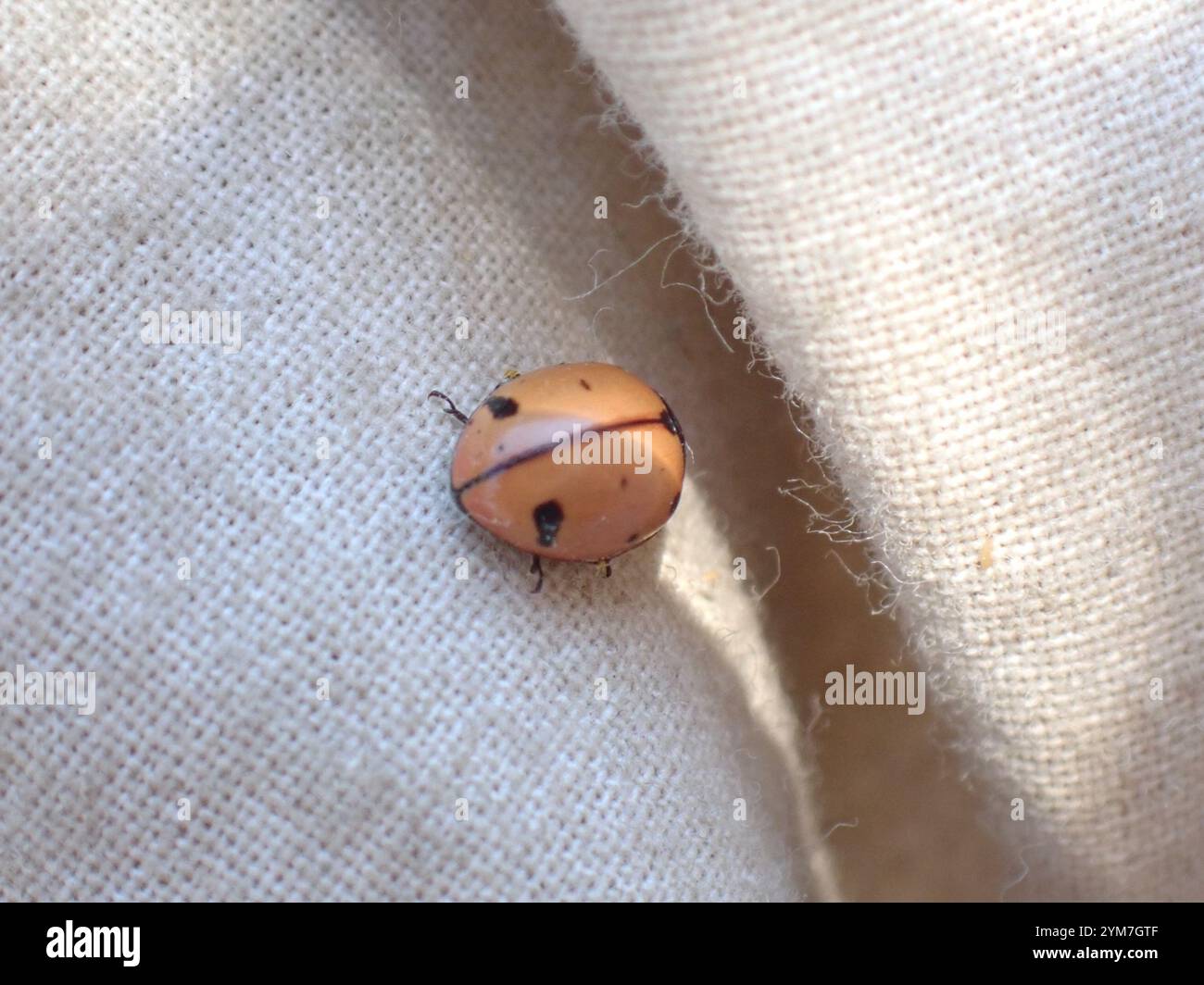 Nine-spotted Lady Beetle (Coccinella novemnotata) Stock Photohttps://www.alamy.com/image-license-details/?v=1https://www.alamy.com/nine-spotted-lady-beetle-coccinella-novemnotata-image632033263.html
Nine-spotted Lady Beetle (Coccinella novemnotata) Stock Photohttps://www.alamy.com/image-license-details/?v=1https://www.alamy.com/nine-spotted-lady-beetle-coccinella-novemnotata-image632033263.htmlRM2YM7GTF–Nine-spotted Lady Beetle (Coccinella novemnotata)
![. Elementary entomology. Insects. FIG. 237. The nine-spotted ladybird-beetle (Cocci- nella noveninotata], — adult and larva (After Chittenden) family feed on plant-lice, scales, and other soft-bodied insects, both as adults and as larvae, and may be found wherever their prey becomes abundant. In general the common yellow or red, black-spotted species feed on plant-lice, while the smaller black species, marked with red or yellowish spots, feed on scales. So common are the lady- birds among colonies of plant-lice that they are frequently mis- ^^ ^ ^ of the aphides, and the misguided grower caref Stock Photo . Elementary entomology. Insects. FIG. 237. The nine-spotted ladybird-beetle (Cocci- nella noveninotata], — adult and larva (After Chittenden) family feed on plant-lice, scales, and other soft-bodied insects, both as adults and as larvae, and may be found wherever their prey becomes abundant. In general the common yellow or red, black-spotted species feed on plant-lice, while the smaller black species, marked with red or yellowish spots, feed on scales. So common are the lady- birds among colonies of plant-lice that they are frequently mis- ^^ ^ ^ of the aphides, and the misguided grower caref Stock Photo](https://c8.alamy.com/comp/RD3XDR/elementary-entomology-insects-fig-237-the-nine-spotted-ladybird-beetle-cocci-nella-noveninotata-adult-and-larva-after-chittenden-family-feed-on-plant-lice-scales-and-other-soft-bodied-insects-both-as-adults-and-as-larvae-and-may-be-found-wherever-their-prey-becomes-abundant-in-general-the-common-yellow-or-red-black-spotted-species-feed-on-plant-lice-while-the-smaller-black-species-marked-with-red-or-yellowish-spots-feed-on-scales-so-common-are-the-lady-birds-among-colonies-of-plant-lice-that-they-are-frequently-mis-of-the-aphides-and-the-misguided-grower-caref-RD3XDR.jpg) . Elementary entomology. Insects. FIG. 237. The nine-spotted ladybird-beetle (Cocci- nella noveninotata], — adult and larva (After Chittenden) family feed on plant-lice, scales, and other soft-bodied insects, both as adults and as larvae, and may be found wherever their prey becomes abundant. In general the common yellow or red, black-spotted species feed on plant-lice, while the smaller black species, marked with red or yellowish spots, feed on scales. So common are the lady- birds among colonies of plant-lice that they are frequently mis- ^^ ^ ^ of the aphides, and the misguided grower caref Stock Photohttps://www.alamy.com/image-license-details/?v=1https://www.alamy.com/elementary-entomology-insects-fig-237-the-nine-spotted-ladybird-beetle-cocci-nella-noveninotata-adult-and-larva-after-chittenden-family-feed-on-plant-lice-scales-and-other-soft-bodied-insects-both-as-adults-and-as-larvae-and-may-be-found-wherever-their-prey-becomes-abundant-in-general-the-common-yellow-or-red-black-spotted-species-feed-on-plant-lice-while-the-smaller-black-species-marked-with-red-or-yellowish-spots-feed-on-scales-so-common-are-the-lady-birds-among-colonies-of-plant-lice-that-they-are-frequently-mis-of-the-aphides-and-the-misguided-grower-caref-image231811939.html
. Elementary entomology. Insects. FIG. 237. The nine-spotted ladybird-beetle (Cocci- nella noveninotata], — adult and larva (After Chittenden) family feed on plant-lice, scales, and other soft-bodied insects, both as adults and as larvae, and may be found wherever their prey becomes abundant. In general the common yellow or red, black-spotted species feed on plant-lice, while the smaller black species, marked with red or yellowish spots, feed on scales. So common are the lady- birds among colonies of plant-lice that they are frequently mis- ^^ ^ ^ of the aphides, and the misguided grower caref Stock Photohttps://www.alamy.com/image-license-details/?v=1https://www.alamy.com/elementary-entomology-insects-fig-237-the-nine-spotted-ladybird-beetle-cocci-nella-noveninotata-adult-and-larva-after-chittenden-family-feed-on-plant-lice-scales-and-other-soft-bodied-insects-both-as-adults-and-as-larvae-and-may-be-found-wherever-their-prey-becomes-abundant-in-general-the-common-yellow-or-red-black-spotted-species-feed-on-plant-lice-while-the-smaller-black-species-marked-with-red-or-yellowish-spots-feed-on-scales-so-common-are-the-lady-birds-among-colonies-of-plant-lice-that-they-are-frequently-mis-of-the-aphides-and-the-misguided-grower-caref-image231811939.htmlRMRD3XDR–. Elementary entomology. Insects. FIG. 237. The nine-spotted ladybird-beetle (Cocci- nella noveninotata], — adult and larva (After Chittenden) family feed on plant-lice, scales, and other soft-bodied insects, both as adults and as larvae, and may be found wherever their prey becomes abundant. In general the common yellow or red, black-spotted species feed on plant-lice, while the smaller black species, marked with red or yellowish spots, feed on scales. So common are the lady- birds among colonies of plant-lice that they are frequently mis- ^^ ^ ^ of the aphides, and the misguided grower caref
 Nine-spotted Lady Beetle (Coccinella novemnotata) Stock Photohttps://www.alamy.com/image-license-details/?v=1https://www.alamy.com/nine-spotted-lady-beetle-coccinella-novemnotata-image637826563.html
Nine-spotted Lady Beetle (Coccinella novemnotata) Stock Photohttps://www.alamy.com/image-license-details/?v=1https://www.alamy.com/nine-spotted-lady-beetle-coccinella-novemnotata-image637826563.htmlRM2S1KE83–Nine-spotted Lady Beetle (Coccinella novemnotata)
![. Elementary entomology. Insects. FIG. 237. The nine-spotted ladybird-beetle (Cocci- nella noveninotata], — adult and larva (After Chittenden) family feed on plant-lice, scales, and other soft-bodied insects, both as adults and as larvae, and may be found wherever their prey becomes abundant. In general the common yellow or red, black-spotted species feed on plant-lice, while the smaller black species, marked with red or yellowish spots, feed on scales. So common are the lady- birds among colonies of plant-lice that they are frequently mis- ^^ ^ ^ of the aphides, and the misguided grower caref Stock Photo . Elementary entomology. Insects. FIG. 237. The nine-spotted ladybird-beetle (Cocci- nella noveninotata], — adult and larva (After Chittenden) family feed on plant-lice, scales, and other soft-bodied insects, both as adults and as larvae, and may be found wherever their prey becomes abundant. In general the common yellow or red, black-spotted species feed on plant-lice, while the smaller black species, marked with red or yellowish spots, feed on scales. So common are the lady- birds among colonies of plant-lice that they are frequently mis- ^^ ^ ^ of the aphides, and the misguided grower caref Stock Photo](https://c8.alamy.com/comp/RCY8BP/elementary-entomology-insects-fig-237-the-nine-spotted-ladybird-beetle-cocci-nella-noveninotata-adult-and-larva-after-chittenden-family-feed-on-plant-lice-scales-and-other-soft-bodied-insects-both-as-adults-and-as-larvae-and-may-be-found-wherever-their-prey-becomes-abundant-in-general-the-common-yellow-or-red-black-spotted-species-feed-on-plant-lice-while-the-smaller-black-species-marked-with-red-or-yellowish-spots-feed-on-scales-so-common-are-the-lady-birds-among-colonies-of-plant-lice-that-they-are-frequently-mis-of-the-aphides-and-the-misguided-grower-caref-RCY8BP.jpg) . Elementary entomology. Insects. FIG. 237. The nine-spotted ladybird-beetle (Cocci- nella noveninotata], — adult and larva (After Chittenden) family feed on plant-lice, scales, and other soft-bodied insects, both as adults and as larvae, and may be found wherever their prey becomes abundant. In general the common yellow or red, black-spotted species feed on plant-lice, while the smaller black species, marked with red or yellowish spots, feed on scales. So common are the lady- birds among colonies of plant-lice that they are frequently mis- ^^ ^ ^ of the aphides, and the misguided grower caref Stock Photohttps://www.alamy.com/image-license-details/?v=1https://www.alamy.com/elementary-entomology-insects-fig-237-the-nine-spotted-ladybird-beetle-cocci-nella-noveninotata-adult-and-larva-after-chittenden-family-feed-on-plant-lice-scales-and-other-soft-bodied-insects-both-as-adults-and-as-larvae-and-may-be-found-wherever-their-prey-becomes-abundant-in-general-the-common-yellow-or-red-black-spotted-species-feed-on-plant-lice-while-the-smaller-black-species-marked-with-red-or-yellowish-spots-feed-on-scales-so-common-are-the-lady-birds-among-colonies-of-plant-lice-that-they-are-frequently-mis-of-the-aphides-and-the-misguided-grower-caref-image231709962.html
. Elementary entomology. Insects. FIG. 237. The nine-spotted ladybird-beetle (Cocci- nella noveninotata], — adult and larva (After Chittenden) family feed on plant-lice, scales, and other soft-bodied insects, both as adults and as larvae, and may be found wherever their prey becomes abundant. In general the common yellow or red, black-spotted species feed on plant-lice, while the smaller black species, marked with red or yellowish spots, feed on scales. So common are the lady- birds among colonies of plant-lice that they are frequently mis- ^^ ^ ^ of the aphides, and the misguided grower caref Stock Photohttps://www.alamy.com/image-license-details/?v=1https://www.alamy.com/elementary-entomology-insects-fig-237-the-nine-spotted-ladybird-beetle-cocci-nella-noveninotata-adult-and-larva-after-chittenden-family-feed-on-plant-lice-scales-and-other-soft-bodied-insects-both-as-adults-and-as-larvae-and-may-be-found-wherever-their-prey-becomes-abundant-in-general-the-common-yellow-or-red-black-spotted-species-feed-on-plant-lice-while-the-smaller-black-species-marked-with-red-or-yellowish-spots-feed-on-scales-so-common-are-the-lady-birds-among-colonies-of-plant-lice-that-they-are-frequently-mis-of-the-aphides-and-the-misguided-grower-caref-image231709962.htmlRMRCY8BP–. Elementary entomology. Insects. FIG. 237. The nine-spotted ladybird-beetle (Cocci- nella noveninotata], — adult and larva (After Chittenden) family feed on plant-lice, scales, and other soft-bodied insects, both as adults and as larvae, and may be found wherever their prey becomes abundant. In general the common yellow or red, black-spotted species feed on plant-lice, while the smaller black species, marked with red or yellowish spots, feed on scales. So common are the lady- birds among colonies of plant-lice that they are frequently mis- ^^ ^ ^ of the aphides, and the misguided grower caref
 Nine-spotted Lady Beetle (Coccinella novemnotata) Stock Photohttps://www.alamy.com/image-license-details/?v=1https://www.alamy.com/nine-spotted-lady-beetle-coccinella-novemnotata-image631446459.html
Nine-spotted Lady Beetle (Coccinella novemnotata) Stock Photohttps://www.alamy.com/image-license-details/?v=1https://www.alamy.com/nine-spotted-lady-beetle-coccinella-novemnotata-image631446459.htmlRM2YK8TB7–Nine-spotted Lady Beetle (Coccinella novemnotata)
 . Elementary entomology. Entomology. l62 ELEMENTARY ENTOMOLOGY. Fig. 237. The nine-spotted ladybird-beetle {Cocci- tiella novemnotata), — adult and larva (After Chittenden) family feed on plant-lice, scales, and other soft-bodied insects, both as adults and as larvae, and may be found wherever their prey becomes abundant. In general the common yellow or red, black-spotted species feed on plant-lice, while the smaller black species, marked with red or yellowish spots, feed on scales. So common are the lady- birds among colonies of plant-lice that they are frequently mis- taken as the parents of Stock Photohttps://www.alamy.com/image-license-details/?v=1https://www.alamy.com/elementary-entomology-entomology-l62-elementary-entomology-fig-237-the-nine-spotted-ladybird-beetle-cocci-tiella-novemnotata-adult-and-larva-after-chittenden-family-feed-on-plant-lice-scales-and-other-soft-bodied-insects-both-as-adults-and-as-larvae-and-may-be-found-wherever-their-prey-becomes-abundant-in-general-the-common-yellow-or-red-black-spotted-species-feed-on-plant-lice-while-the-smaller-black-species-marked-with-red-or-yellowish-spots-feed-on-scales-so-common-are-the-lady-birds-among-colonies-of-plant-lice-that-they-are-frequently-mis-taken-as-the-parents-of-image231764062.html
. Elementary entomology. Entomology. l62 ELEMENTARY ENTOMOLOGY. Fig. 237. The nine-spotted ladybird-beetle {Cocci- tiella novemnotata), — adult and larva (After Chittenden) family feed on plant-lice, scales, and other soft-bodied insects, both as adults and as larvae, and may be found wherever their prey becomes abundant. In general the common yellow or red, black-spotted species feed on plant-lice, while the smaller black species, marked with red or yellowish spots, feed on scales. So common are the lady- birds among colonies of plant-lice that they are frequently mis- taken as the parents of Stock Photohttps://www.alamy.com/image-license-details/?v=1https://www.alamy.com/elementary-entomology-entomology-l62-elementary-entomology-fig-237-the-nine-spotted-ladybird-beetle-cocci-tiella-novemnotata-adult-and-larva-after-chittenden-family-feed-on-plant-lice-scales-and-other-soft-bodied-insects-both-as-adults-and-as-larvae-and-may-be-found-wherever-their-prey-becomes-abundant-in-general-the-common-yellow-or-red-black-spotted-species-feed-on-plant-lice-while-the-smaller-black-species-marked-with-red-or-yellowish-spots-feed-on-scales-so-common-are-the-lady-birds-among-colonies-of-plant-lice-that-they-are-frequently-mis-taken-as-the-parents-of-image231764062.htmlRMRD1NBX–. Elementary entomology. Entomology. l62 ELEMENTARY ENTOMOLOGY. Fig. 237. The nine-spotted ladybird-beetle {Cocci- tiella novemnotata), — adult and larva (After Chittenden) family feed on plant-lice, scales, and other soft-bodied insects, both as adults and as larvae, and may be found wherever their prey becomes abundant. In general the common yellow or red, black-spotted species feed on plant-lice, while the smaller black species, marked with red or yellowish spots, feed on scales. So common are the lady- birds among colonies of plant-lice that they are frequently mis- taken as the parents of
 Nine-spotted Lady Beetle (Coccinella novemnotata) Stock Photohttps://www.alamy.com/image-license-details/?v=1https://www.alamy.com/nine-spotted-lady-beetle-coccinella-novemnotata-image637807653.html
Nine-spotted Lady Beetle (Coccinella novemnotata) Stock Photohttps://www.alamy.com/image-license-details/?v=1https://www.alamy.com/nine-spotted-lady-beetle-coccinella-novemnotata-image637807653.htmlRM2S1JJ4N–Nine-spotted Lady Beetle (Coccinella novemnotata)
 Nine-spotted Lady Beetle (Coccinella novemnotata) Insecta Stock Photohttps://www.alamy.com/image-license-details/?v=1https://www.alamy.com/nine-spotted-lady-beetle-coccinella-novemnotata-insecta-image615397068.html
Nine-spotted Lady Beetle (Coccinella novemnotata) Insecta Stock Photohttps://www.alamy.com/image-license-details/?v=1https://www.alamy.com/nine-spotted-lady-beetle-coccinella-novemnotata-insecta-image615397068.htmlRM2XN5N6M–Nine-spotted Lady Beetle (Coccinella novemnotata) Insecta
 Nine-spotted Lady Beetle (Coccinella novemnotata) Insecta Stock Photohttps://www.alamy.com/image-license-details/?v=1https://www.alamy.com/nine-spotted-lady-beetle-coccinella-novemnotata-insecta-image613485225.html
Nine-spotted Lady Beetle (Coccinella novemnotata) Insecta Stock Photohttps://www.alamy.com/image-license-details/?v=1https://www.alamy.com/nine-spotted-lady-beetle-coccinella-novemnotata-insecta-image613485225.htmlRM2XJ2JJH–Nine-spotted Lady Beetle (Coccinella novemnotata) Insecta
 Nine-spotted Lady Beetle (Coccinella novemnotata) Insecta Stock Photohttps://www.alamy.com/image-license-details/?v=1https://www.alamy.com/nine-spotted-lady-beetle-coccinella-novemnotata-insecta-image621664063.html
Nine-spotted Lady Beetle (Coccinella novemnotata) Insecta Stock Photohttps://www.alamy.com/image-license-details/?v=1https://www.alamy.com/nine-spotted-lady-beetle-coccinella-novemnotata-insecta-image621664063.htmlRM2Y3B6RY–Nine-spotted Lady Beetle (Coccinella novemnotata) Insecta
 Nine-spotted Lady Beetle (Coccinella novemnotata) Insecta Stock Photohttps://www.alamy.com/image-license-details/?v=1https://www.alamy.com/nine-spotted-lady-beetle-coccinella-novemnotata-insecta-image621671554.html
Nine-spotted Lady Beetle (Coccinella novemnotata) Insecta Stock Photohttps://www.alamy.com/image-license-details/?v=1https://www.alamy.com/nine-spotted-lady-beetle-coccinella-novemnotata-insecta-image621671554.htmlRM2Y3BGBE–Nine-spotted Lady Beetle (Coccinella novemnotata) Insecta

